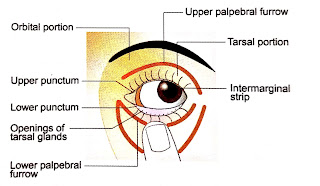Eyelid anatomy
Eyelid anatomy | Eyelid meaning in hindi | Gross anatomy of eyelid
GROSS ANATOMY
The eyelids are mobile tissue curtains placed in front of the eyeballs. These act as shutters protecting the eyes from injuries and excessive light.
These also perform an important function of spreading the tear film over the cornea and conjunctiva and also help in drainage of tears by lacrimal pump system.
Parts of eyelid.
Each eyelid is divided by a horizontal furrow (sulcus) into an orbital and tarsal part.
Position of lids.
When the eye is open, the upper lid covers about one-sixth of the cornea and the lower lid just touches the limbus.
Canthi.
The two lids meet each other at medial and lateral angles (or outer and inner canthi). The medial canthus is about 2 mm higher than the lateral canthus.
Palpebral aperture.
It is the elliptical space between the upper and the lower lid. When the eyes are open it measures about 10-11 mm vertically in the centre and about 28-30 mm horizontally.
The lid margin.
It is about 2-mm broad and is divided into two parts by the punctum. The medial, lacrimal portion is rounded and devoid of lashes or glands.
The lateral, ciliary portion consists of a rounded anterior border, a sharp posterior border (placed against the globe) and an intermarginal strip.
The grey line (which marks junction of skin and conjunctiva) divides the intermarginal strip into an anterior strip bearing 2-3 rows of lashes and a posterior strip on which openings of meibomian glands are arranged in a row.
The splitting of the eyelids when required in operations is done at the level of grey line.
OPTOMETRY-SHARP VISION
Optometrist

